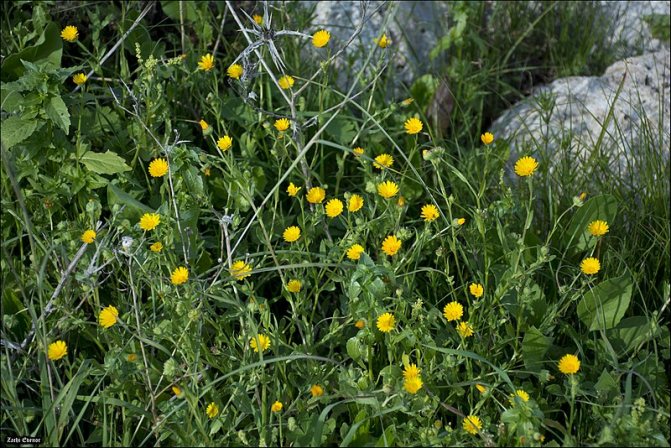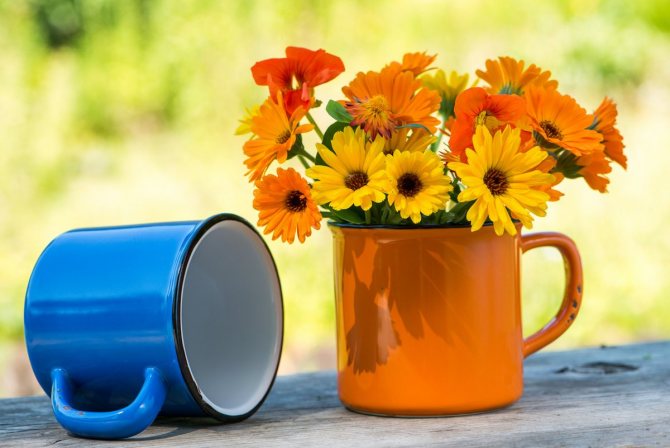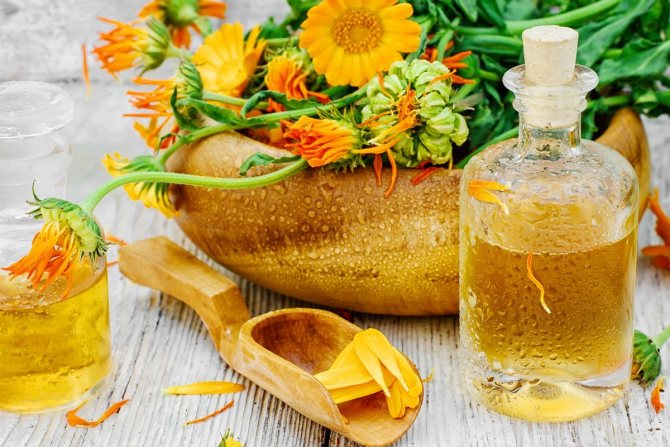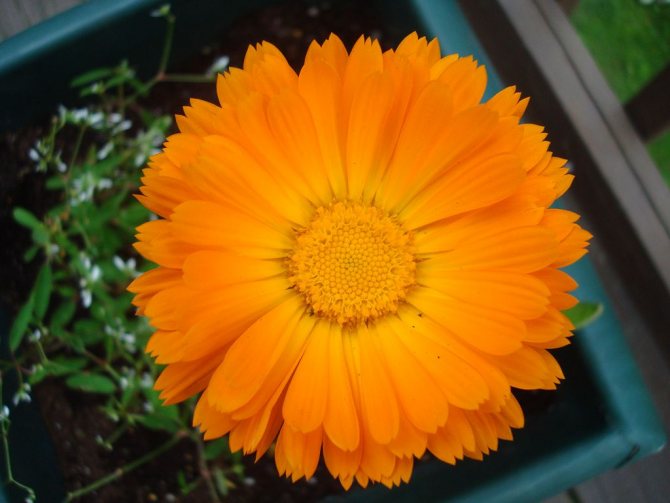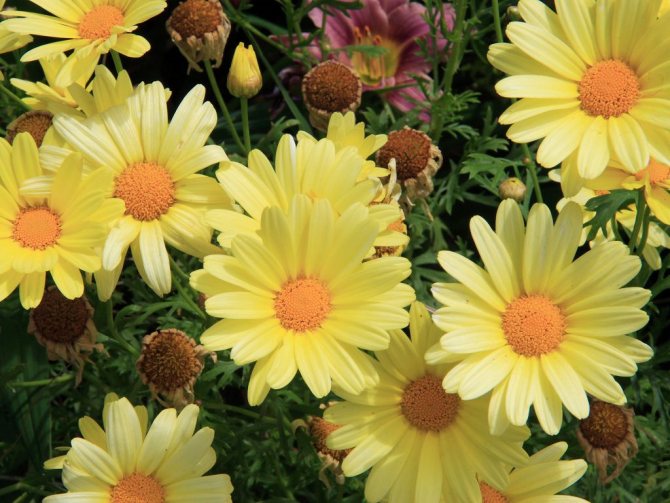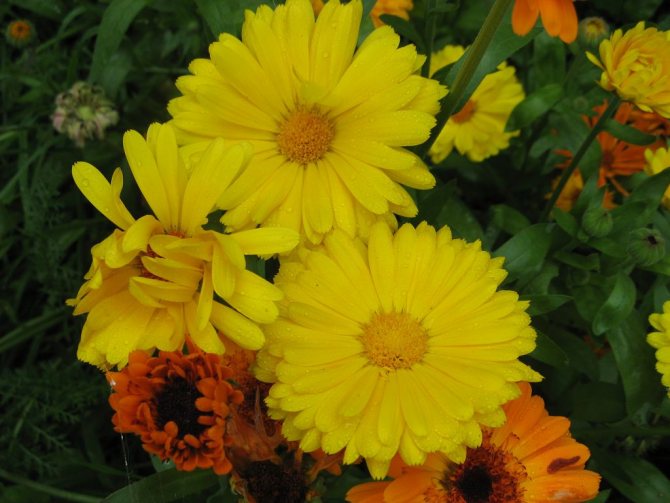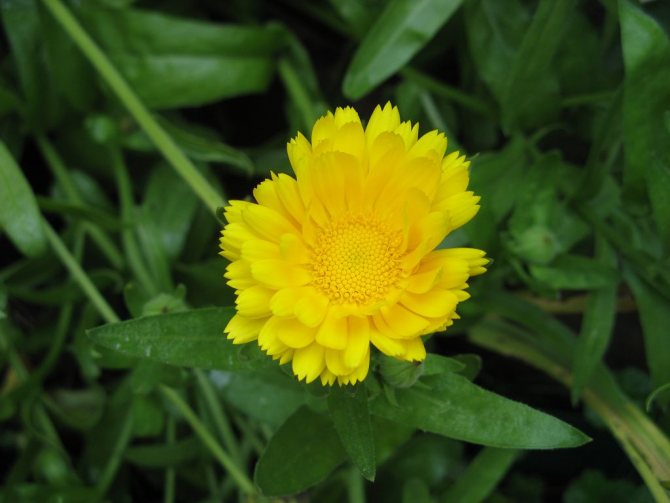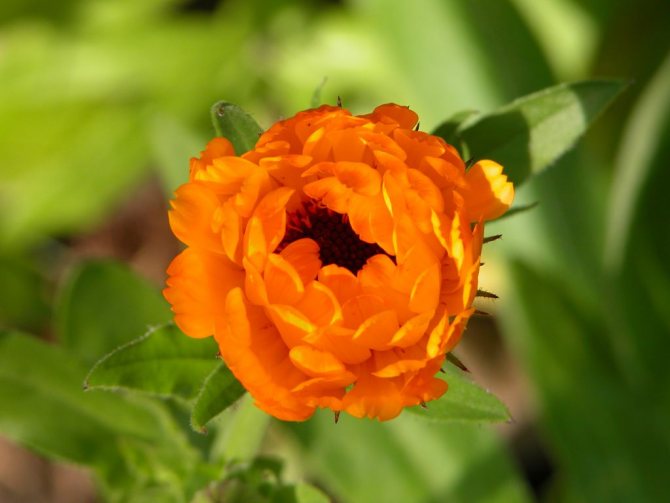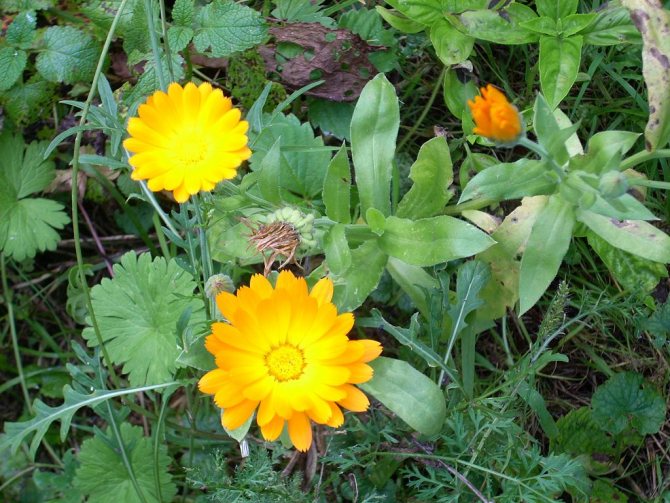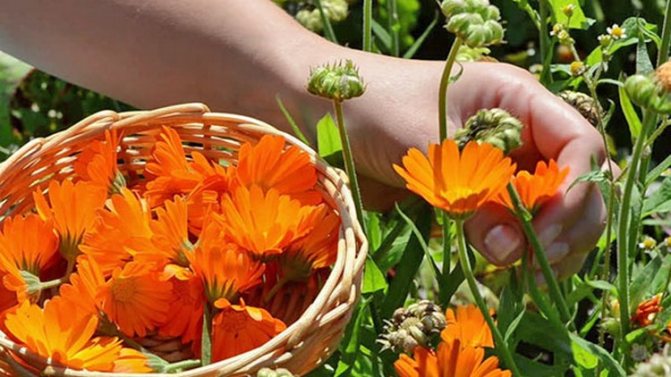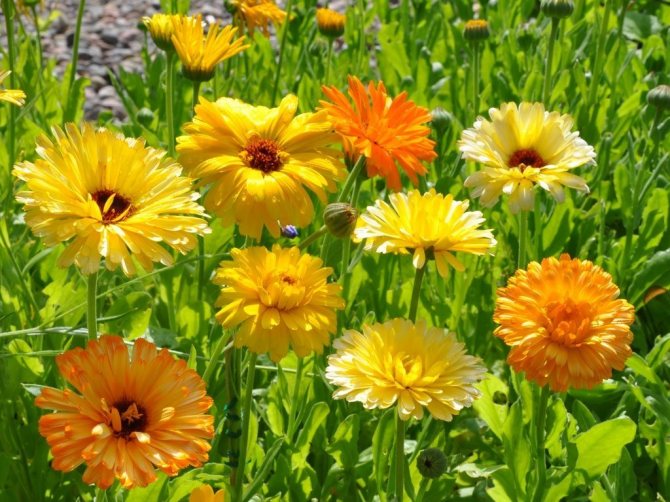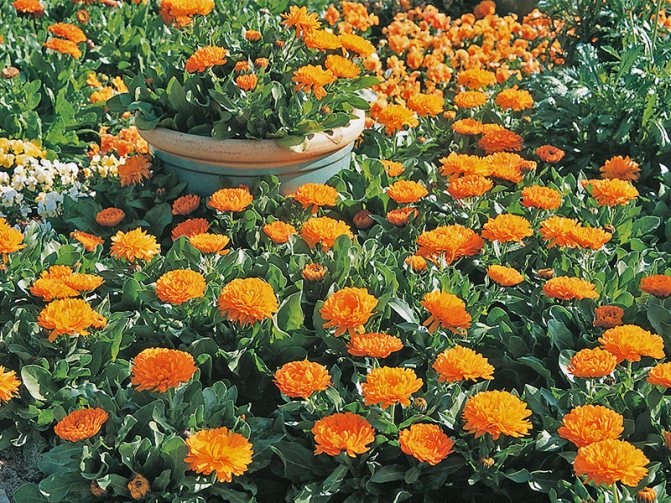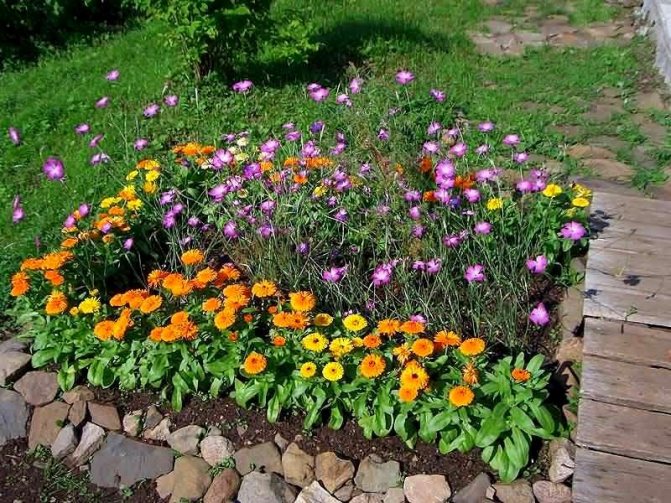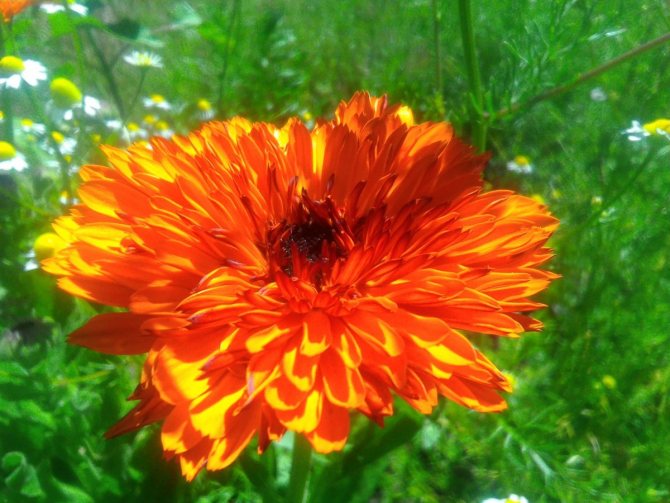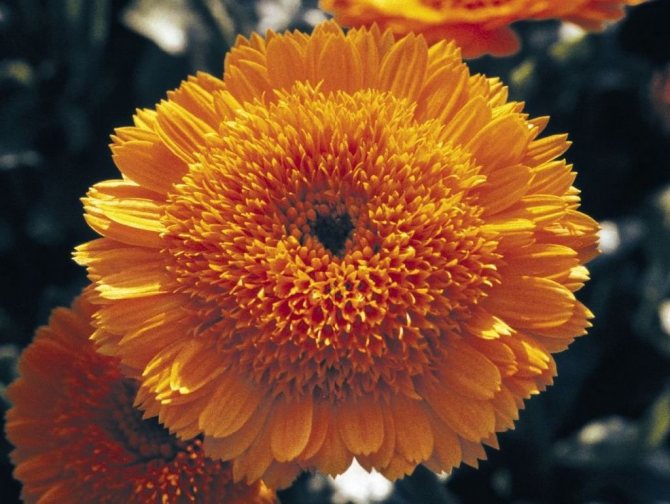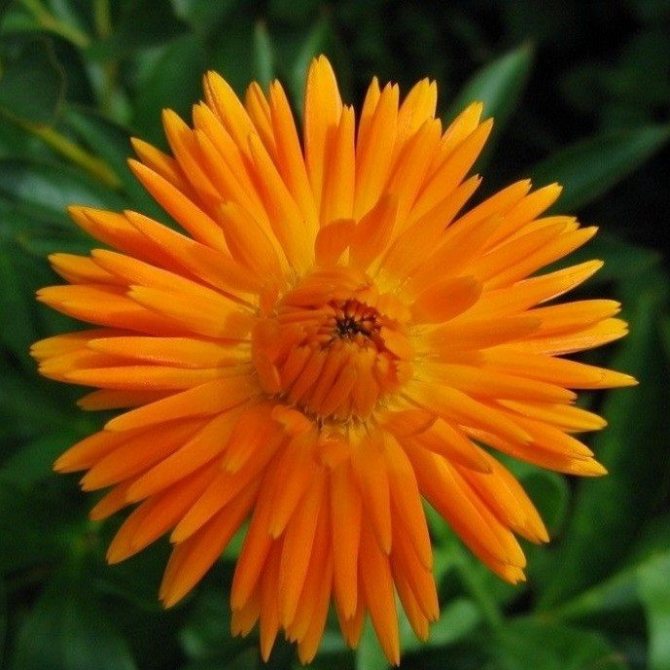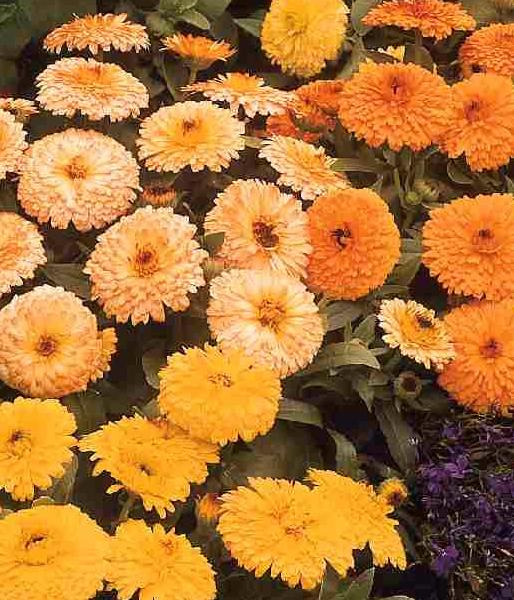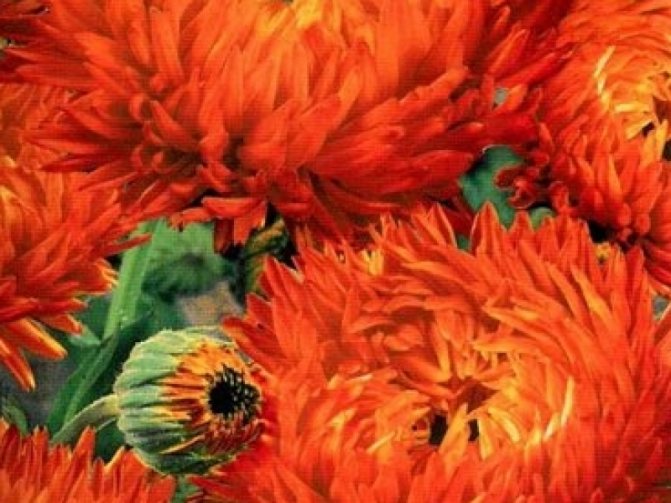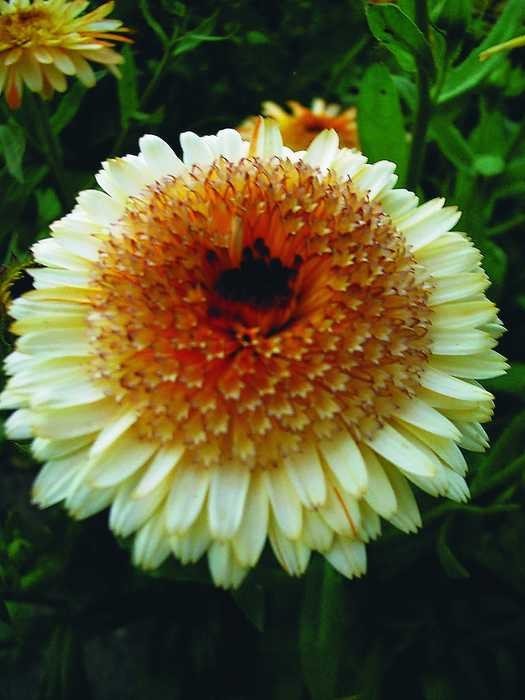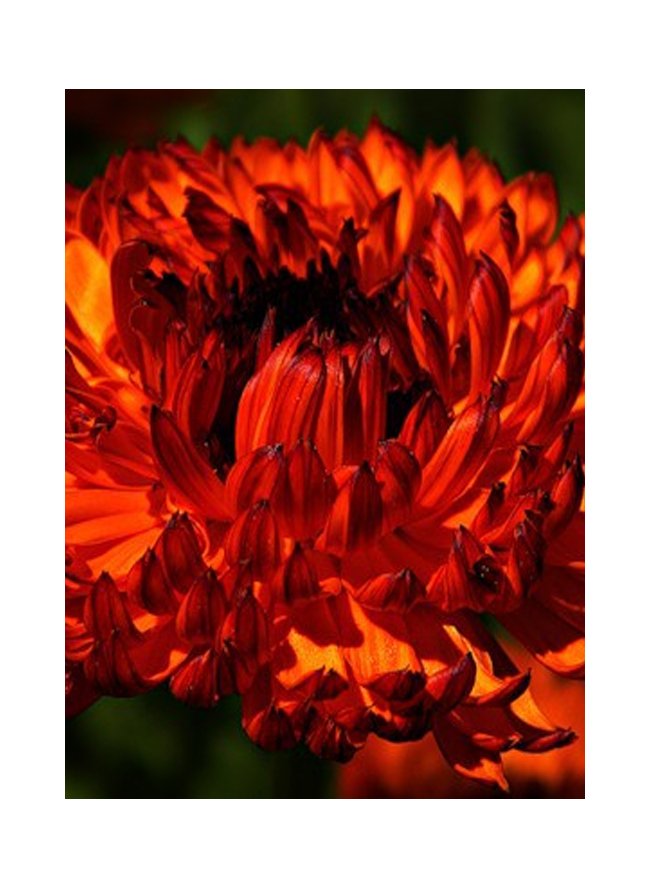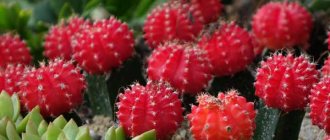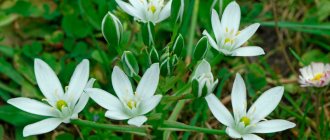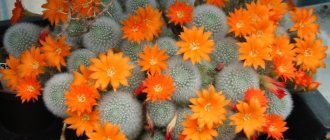Calendula officinalis is a genus of about 20 species, which differ in height, size, shape of flowers, their color, shade, and also come in double and non-double forms. Grown as an ornamental plant. Belongs to the Compositae family.
Calendula is one of the most used plants in folk medicine, and is also recognized as official medicine. It is widely used in the cosmetic industry in the production of various skin and hair care products.
The flowers of the plant are used in cooking as a seasoning, as well as in the food industry for coloring and flavoring margarine, butter, cheese, etc.
Latin name: Calendula officinalis L.
Other names: marigolds, pharmaceutical marigold, medicinal marigolds, crocis.
Description
Calendula is a herbaceous plant. The flower is usually orange or yellow in color. Represents apical baskets, which include flowers of a darker color.
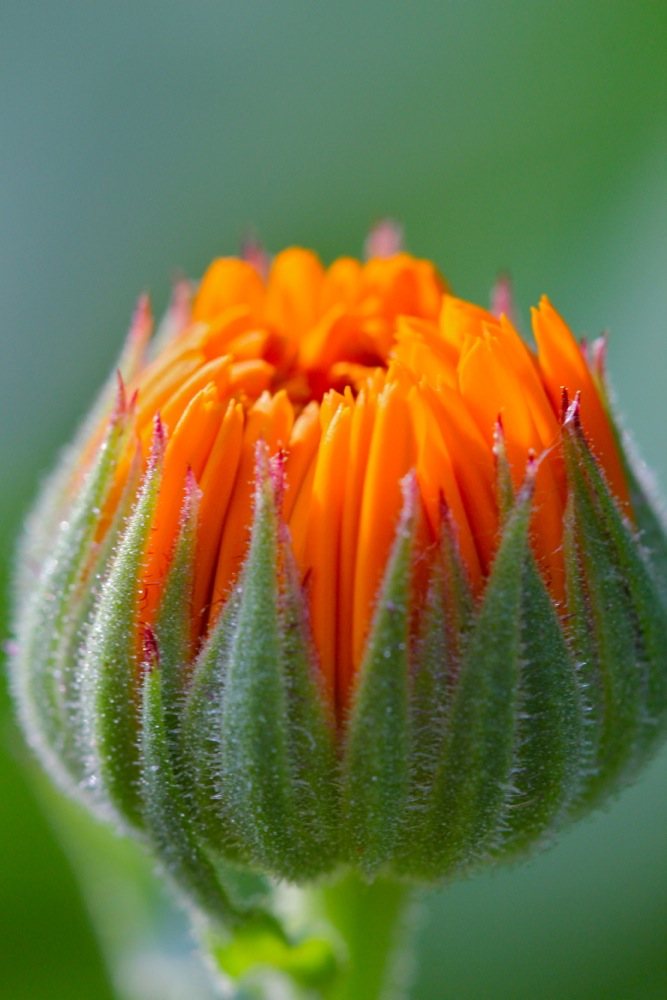
The plant has simple leaves. They can be oval shaped. Lanceolate leaves are possible, some of them are elongated. The calendula flower in the photo is presented in the article.
The fruits of the flower are curved achenes, in some cases annular. They are arranged in several rows, usually two or three.
The flowering period is quite long. Calendula begins to bloom in June and fades towards the end of November. The plant is resistant to temperature extremes, the seeds germinate for up to five years, which is not typical for garden plants. Photos of calendula flowers in a flower bed can be seen in our article. As an ornamental flower, the plant has been used since the 16th century.
Collection and procurement
For medicinal purposes, mainly calendula flowers are used, less often grass. The plant blooms profusely and flowers open every 3-5 days, which should be removed from the bushes completely. This method promotes further abundant flowering and prevents seed formation.
Raw materials are dried, as usual, in the shade, spread in a thin layer, not forgetting to stir from time to time. Store in linen or paper bags / bags, cardboard boxes. Shelf life is 1-2 years.
How is the sowing of seeds in open ground carried out?
Most gardeners choose to plant marigold seeds outdoors in April. Some summer residents do not share this opinion. They start planting seeds before winter.
In the spring, it is better to choose the time for planting when the ground has already warmed up. It is important that the soil is not soggy.
When a decision is made to plant calendula in a certain place, then two weeks before that it is necessary to dig up the site, adding humus to the soil. You should also add twenty grams of superphosphate per unit area and potassium chloride in the same volume. Urea will be required, it must be added to the soil by thirty grams per unit area. Such activities for fertilizing the land are best carried out in the fall. In this case, in the spring, you will only need to add fertilizer with nitrogen.
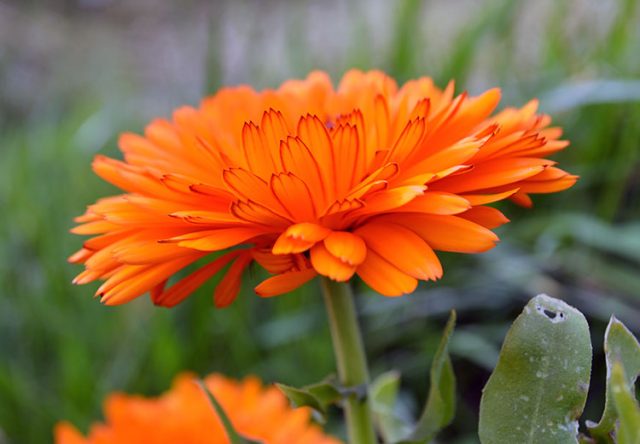

It is necessary to make a depression in the soil for one, maximum two centimeters, and plant calendula seeds. There should be a distance of 25-30 centimeters between them.
Each row should deviate from the past by 60-70 centimeters. Such spacing is acceptable for ornamental plants.If a person plants "marigolds" in order to obtain medicinal material, then the rows should be kept 30 centimeters apart.


The sprouts appear in one to two weeks. After three weeks, you need to thin out the plants. The interval between them, ideally, should be no more than 35 centimeters. A photo of the calendula plant can be seen below in the article.
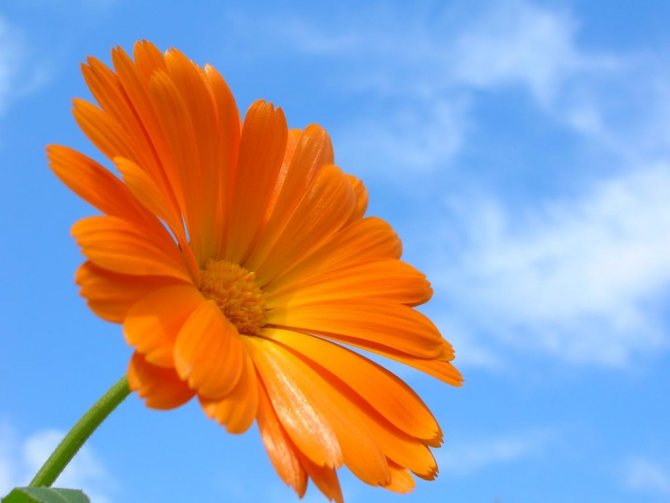

Excess shoots can be transplanted somewhere else, they easily tolerate a change in soil. The main thing is to observe the watering regime. Flowering will begin in ten weeks.
Dosage forms
Infusion of calendula


1 tsp pour 250 ml of flowers. boiling water. Cover with a lid, insulate and insist until warm. Strain. Store in a cool place for no more than 2 days.
Take half a glass 3-4 times a day warm.
Tincture of calendula
1 tbsp pour 100 ml of flowers. 70% alcohol or quality vodka. Close the container tightly and leave in a dark place at room temperature for a week. Strain, squeeze the raw material.
Application of calendula tincture
General rules. Take 1 tsp. 2-3 times a day for 20 minutes. before meals. For external use (douching, rinsing, enemas, etc.), dilute 1 tsp. tinctures in 1 tbsp. water.
Flu, colds. Brew tea with lingonberries and / or raspberries. When it cools down to 40 ° C, add 1 tsp. tincture and 1 tsp. honey.
Drink 1 tbsp. big sips before bedtime.
Cough. Place 10 drops of the tincture on the sugar cube. Suck like candy. Take 3-4 times a day.
Marigold juice


Grind fresh flowers with a meat grinder and squeeze the juice from the resulting mass through cheesecloth folded in several layers. Place the juice in a water bath, bring to a boil and boil for 5 minutes. Keep refrigerated.
Application
Internal. 20-40 drops of juice and 1/2 tablespoon dissolve honey in 1 tbsp. milk. This is a single dose. Take 2-3 times daily before meals.
Outside. The juice is diluted with water in a ratio of 1: 2 or 1: 3.
Calendula ointment
The ointment is prepared from fresh flowers and melted pork fat, taken in a ratio of 1: 5 (by weight). Grind the flowers with a meat grinder. Place the resulting mass in a bowl, add fat and, stirring constantly, bring in a water bath until smooth. Remove from heat, cool and pour into a glass jar. Keep refrigerated.
What does calendula ointment help with? Any skin damage, bacterial or fungal skin infection, rash, allergies, itching, varicose veins, as a skin care product for both men and women, etc.
Calendula oil
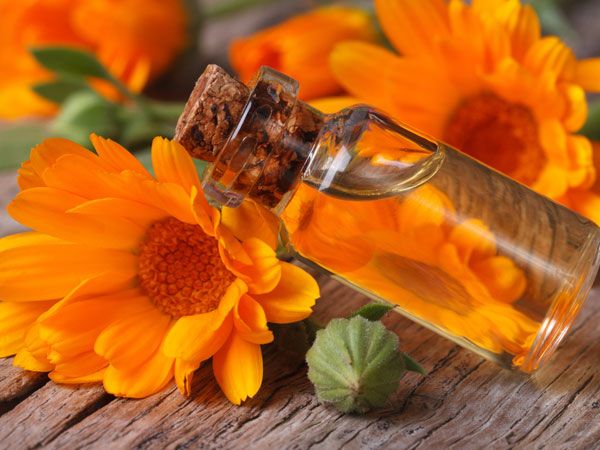

Fill a glass jar 3/4 full with fresh flowers. Pour sunflower oil or, better, olive oil to the brim. Cover tightly and leave in a dark place at room temperature for two weeks, remembering to stir occasionally. Strain, squeeze the raw material.
Calendula oil. Properties. Anti-inflammatory, bactericidal, disinfectant.
Applying calendula oil
Internal use. Drink 1 tbsp. 2 times a day, half an hour before meals for various diseases of the gastrointestinal tract, liver and gallbladder, as a sedative, for diseases of the nervous system, menopause.
External use. Any damage to the skin, bruising (including in the form of an oil bandage), eczema, varicose veins, as a means of skin care.
How to plant calendula seedlings?
Many summer residents want to speed up the flowering process of the described plant. For this, people choose the seedling method. This method is also used to obtain a low-growing variety.
Seeds are planted indoors at the end of March. Some people choose large pots for planting. Some gardeners use disposable cups.It is necessary to make a depression in the ground no more than two centimeters. After the planting process is completed, the seeds are covered with foil. Containers with seeds must be placed in a bright place, which is reliably protected from direct sunlight. The air temperature should be at least plus 18 degrees and not higher than plus 20 degrees.
Useful and medicinal properties of calendula
The healing and beneficial properties of calendula are extensive and versatile. The plant possesses:
- antibacterial,
- antiviral,
- anti-inflammatory,
- wound healing
- astringent,
- pain relievers
- antispasmodic,
- diaphoretic
- expectorant
- choleretic
- diuretic,
- calming,
- hematopoietic,
- blood-purifying,
- antitoxic,
- anti-rachitic actions.
In addition, calendula improves metabolic processes in the body, is an antioxidant.
How to choose a suitable site?
The place where the calendula will grow should be in the sun. It is better to moisten the soil and make drainage. It is believed that if you plant calendula between vegetable beds, then pests will not attack the crops. It is worth considering that you cannot plant basil and radish next to this plant. Calendula roots secrete certain substances that slow down the growth of these crops. When choosing a place on the site, it is worth deciding in advance which garden crops the calendula will grow next to. A photo of the flower is presented below.
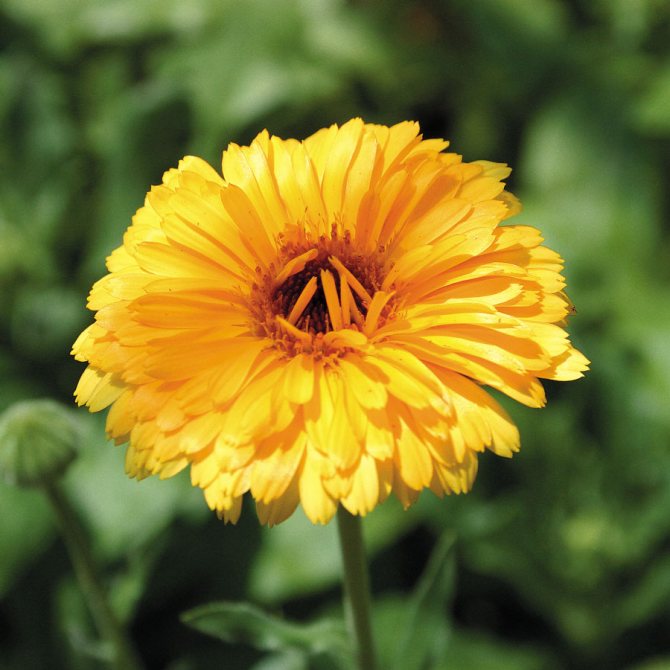

History of calendula
The name of this plant is directly related to the history of calendula and the peculiar behavior of the flower. Even the ancient Romans noticed that bright yellow flowers, themselves similar to the sun, turn after him, spreading their petals, like hands on a clock dial. And in the shade, the flower gathers the petals in a bunch. This is why calendula was called the flower of the sun, the sun dial and the bride of summer. It was also noticed that the plant announces the beginning of the day and night as a kind of calendar, hence the name calendae, which means "the first day of the month" in Latin.
It was in Ancient Rome, and then in Ancient Greece, that the unique medicinal properties of the plant were recognized and they began to use it for medicinal purposes. Later, the fame of the flower's ability to heal ailments reached Europe and penetrated into Russia.
Or maybe people themselves understood the healing power of the flower and came up with various ways to use it. In Russia, calendula has been cultivated as a medicinal and ornamental plant since the 12th century.
In Europe, the history of the flower is overgrown with legends and traditions. Calendula was especially fond of in medieval France. It was the favorite flower of the Queen of Navarre, Margaret of Valois. The statue of the queen with a calendula flower in her hands, standing in the Luxembourg Gardens in Paris, has become a monument not only to a woman, but also to a flower.
Calendula was considered a symbol of constancy in love, so grooms gave bouquets of sun baskets to their lovers, these flowers decorated wedding celebrations, and girls wove wreaths from calendula, which they used to decorate themselves on birthdays or name days.
How to care for calendula in the garden?
It doesn't take much effort to grow flowers. In dry weather, it is necessary to increase watering. Periodically it is required to weed the beds, loosen the soil. The soil needs to be fertilized once a month.
Gardeners advise: as soon as the calendula blooms and the basket takes a horizontal position, it is necessary to cut off all the opened flowers. This technique promotes long-term flowering. There are more buds. Blooming will not stop until autumn. To achieve this effect, you need to regularly collect the inflorescences. If you ignore this advice, then the plant will bloom until the end of July. How the calendula looks in the photo during active flowering can be seen later in the article.
Suitable for commercial cultivation
Types of calendula with a photo:
| Calendula stunted Description:
|
| Calendula Geisha Description:
|
| Kabloon Description:
|
| Calendula red Description:
|
What diseases do “marigolds” have?
It happens that calendula is affected by diseases caused by fungi or pests. Allocate black spot and powdery mildew. From the first ailment, characteristic dark spots appear on the leaves of calendula. They come in black as well as brown. Powdery mildew can be identified by the white bloom on the plant, which darkens over time. The areas begin to turn black. The plant loses its cold resistance.
To eliminate the disease, gardeners recommend treating plants with the following preparations:
- "Skor" and "Topaz" help well against spotting. They also actively fight dew traces.
- "Fundazol" and "Topsin" are excellent means for combating fungal infections of calendula.
Problems can arise if flowers are planted too close to each other. It is important to thin out the seedlings in a timely manner.
Do not get carried away with fertilizers. An excessive amount of nitrogen fertilizers in the soil causes severe damage to young plants. The soil remains oversaturated. For the winter, it is necessary to dig up the fertilized area. Diseased sprouts must be removed from the beds immediately so that they do not infect other flowers.
Therapeutic effect on the body
The use of calendula in folk and official medicine is wide, but in order for the treatment to be beneficial, the indications for the use of calendula should be taken into account, and this can only be done by a doctor (preferably a phytotherapist) after a comprehensive examination. He will also take into account the contraindications of calendula. The information given below is for informational purposes only.
For the heart and blood vessels
Plant preparations (infusion, alcohol tincture of calendula, juice) have proven themselves well for the treatment of cardiovascular diseases. Calendula is recommended for atherosclerosis, it helps to cleanse blood vessels, strengthens their walls.
In addition, flowers normalize cardiac activity, reduce heart rate, increase the amplitude of heart contractions, and reduce shortness of breath. Based on this, they are used for angina pectoris and other similar diseases.
Also, calendula medicinal preparations are an effective remedy for mild pressure reduction, reduce edema of cardiac origin.
Gastrointestinal diseases
Traditional and official medicine appreciated the medicinal properties of calendula and its use for the treatment of many diseases of the gastrointestinal tract is widespread. The preparations of the plant increase the production of gastric juice, while reducing its aggressiveness, increase the resistance of the mucous membrane, and improve appetite. They are used for stomach and intestinal cramps, vomiting.
Calendula, acting anti-inflammatory, is used to treat gastritis, gastric and duodenal ulcers, colitis, enterocolitis and other inflammatory and erosive diseases.
For treatment, it is recommended to use an alcoholic tincture of calendula, an infusion, as well as plant juice.
With a cold
The use of the medicinal properties of calendula has shown its effectiveness in various colds of the upper respiratory tract. It is used both by itself and as a component of numerous recipes.
Very good results are obtained by gargling with calendula tincture or infusion. The juice is used for washing, and also instilled into the nose with a cold.
Internal intake of infusion with honey helps with coughing, dilutes phlegm, promotes its discharge, and also improves general condition and promotes faster recovery.
The concurrent administration of calendula and sulfonamides with antibiotics is a very effective method for treating angina.
For the liver
The medicinal and beneficial properties of calendula are applicable for various diseases of the liver and gallbladder. Its use increases bile formation, acts as a choleretic, eliminates stagnation of bile in the gallbladder.
The use of calendula is recommended for hepatitis, inflammation of the bile ducts, cholelithiasis and other diseases.
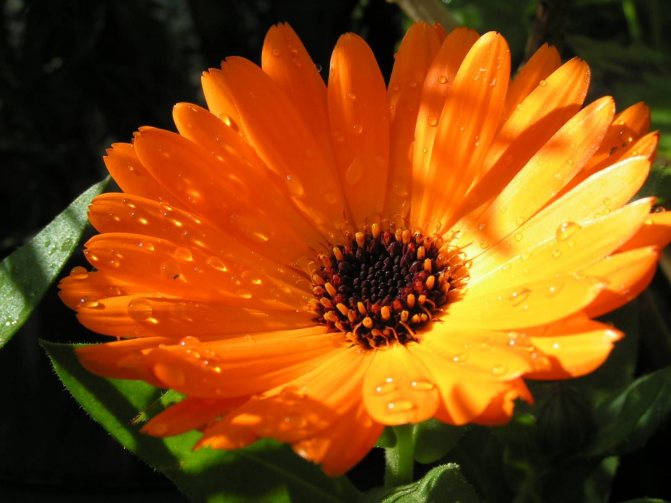

To enhance the action for these purposes, they drink it together with pharmaceutical chamomile or with chamomile and yarrow.
For women
Useful and medicinal properties of calendula are used in diseases of the female genital area is very extensive. Calendula in gynecology (infusion, tincture, juice) is used in the form of douching for cervical erosion and uterine fistulas, Trichomonas colpitis, leucorrhoea, etc.
Internal intake of plant preparations normalizes the menstrual cycle, helps with a delay in menstruation. In the premenopausal period and with menopause, calendula eliminates unpleasant symptoms.
In addition, the plant is very widely used in cosmetology, including home. The use of calendula tincture for acne gives a good result. In addition, calendula is used for the skin of the face and for the hair (rinsing).
For kids
Calendula for children is of great help. With the infusion and tincture of the plant (solution), wipe the mucous membrane of the mouth with thrush using tampons. For various inflammatory processes in the oral cavity, rinses are performed.
Plant preparations are used for washing, rubbing, making lotions for various skin lesions in children, such as scuffs, diaper rash, etc., as well as other diseases such as diathesis, childhood eczema, scrofula, lichen, allergies, etc.
Also, for medicinal purposes and as a prophylaxis, calendula is used for babies. The infusion of the plant is a good bathing agent. In addition, the use of calendula oil will help in caring for the delicate skin of a child, including with various damages.
Wounds, ulcers, abscesses ...
The useful and medicinal properties of calendula provide effective assistance for various damage to the skin. Its external use accelerates the restoration of damaged tissues, has an antibacterial and anti-inflammatory effect. With this treatment, scars either do not form at all or they are more delicate, the bruises dissolve faster.
Indications for the use of calendula: wounds, abrasions, bruises, ulcers, including leg ulcers, gangrene, burns, frostbite, skin cracks, bedsores, diaper rash, abrasions, fistulas, boils, tumors, itching, various irritations, etc.
All calendula preparations are used for treatment: infusion, tincture, juice, oil and ointment.
For the treatment of corns, warts, fungal diseases, fresh well-mashed leaves or flowers are applied to the damaged areas.
Gardeners reviews
Atlantis, Gelendzhik
The calendula does not require special care. Watering as needed. On the balcony I feed mine. I remove the faded flowers. Calendula blooms until frost. Looks very good with blue flowered plants.
Tatiana Varlamova, Moscow region
By the way, calendula is especially famous for its antibacterial properties, therefore, with chronic tonsillitis and with angina, it is simply an irreplaceable herb.
Plant care
Planting calendula and caring for flowers is not difficult. Due to the unpretentious nature and easy reproduction, the maintenance of the plant will not cause difficulties. For good growth and abundant flowering, you need to choose a well-lit place for planting, but at the same time the flower develops well in diffused light and in partial shade. However, with a lack of light, the plant can get sick with powdery mildew, and its decorative appearance also deteriorates.
Plants require regular and abundant watering, especially during the period of sprouting. An adult plant can easily survive the dry season without watering, but the number of flowers on the bush will decrease.
For prolonged flowering, the inflorescences should be cut frequently. This procedure has two goals: firstly, the calendula is harvested for further drying, and secondly, the plant reacts to cutting flowers with even more magnificent flowering.
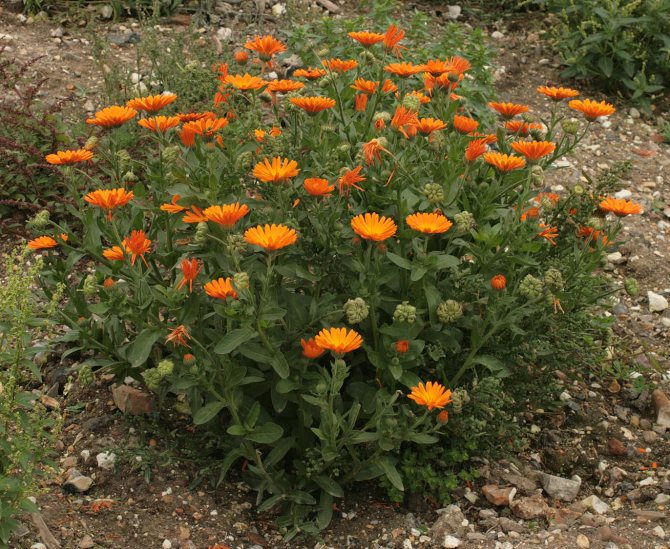

Flowers are harvested in the morning in clear weather, after the dew has dried. Only the flowers themselves are cut with a small fragment of the peduncle. Cutting time comes when most of the flowers on the bush are in full bloom. The plant reproduces easily by self-seeding. To avoid this, collect the seed baskets before they begin to crumble. As soon as most of the seeds have darkened, the basket is cut off, the rest of the seeds ripen quietly when dried.
In addition to the decorative effect, marigolds bring considerable benefits to the soil where they grow. They are able to disinfect soil from pathogenic microbes, save nearby growing garden crops and flowers from various harmful insects.
Use in landscape design
Solar calendula is used in the garden to decorate a flower bed in a rustic style, the plant will perfectly complement mixborders, rabatki, and decorate balconies and terraces.


Low-growing varieties are used for group belt or carpet plantings located on the lawn. Tall specimens are used as backgrounds.
Companions for group plantings of marigolds are most often ageratums, zinnias, cornflowers, rudbeckia, escholtia.
Things to remember
- Plant with seeds and seedlings. Grow seedlings for early flowering. Sow directly into the soil in spring and autumn.
- Water, loosen, feed. Care for the plantings - water often in small amounts, loosen the ground after watering, feed twice with nitrogen and mineral fertilizers.
- Use in landscaping. Small varieties look good in pots and containers on balconies and loggias. Medium and tall types are used to decorate flower beds.
Diseases and pests
| Powdery mildew Ways to fight:
|
| Black spot Ways to fight:
|
| Aphid Ways to fight:
|
Breeding flowers
Calendula has gained its popularity due to its decorative and healing properties. Gardeners breed marigolds for many reasons:
- decorate a personal plot;
- make medicinal potions;
- protect other plants from pests.
To prepare healing potions, use only blossoming inflorescences. Petals are used to treat many pathologies, since they have the following properties:
- wound healing;
- antispasmodic;
- bactericidal;
- sedative;
- fortifying;
- diaphoretic.
The plant is also bred for cosmetic purposes. Marigold infusions strengthen hair roots well, cleanse the face.
In addition, marigolds protect vegetables from attack by caterpillars, ticks, Colorado beetles and other garden pests. .
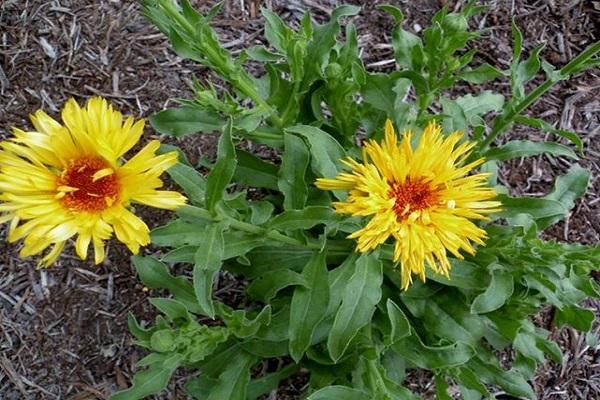

Contraindications to the use of calendula
Calendula, as a medicinal plant, has practically no contraindications. It may be contraindicated for people suffering from hypotension (low blood pressure), as well as those with individual intolerance.
Before using prescriptions, a consultation with a doctor is required!
All about growing calendula on a personal plot,
If you have experience in using this plant, please do not be lazy and leave a comment on the article !!!
After flowering
Seed collection
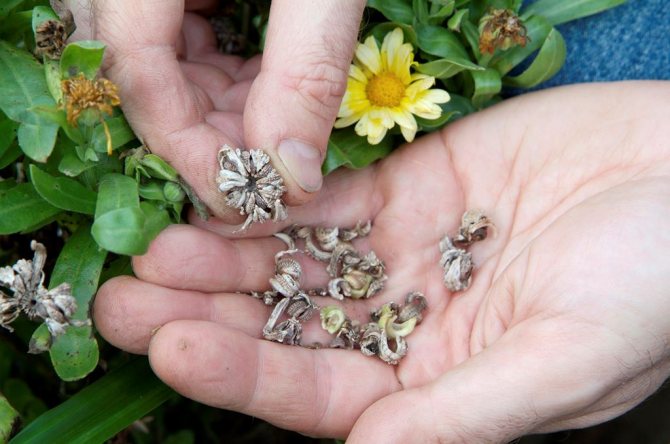

The collection of seeds should be carried out after they are almost fully ripe. To prevent self-seeding, a small bag of gauze should be put on the wilted inflorescences, while fixing it on the stem.
Wintering
Marigolds are annuals, in this regard, after they stop blooming, the bushes need to be dug up and removed from the site.
Types and varieties
Among the crops grown, there are two main types of marigolds: field and medicinal. The first species grows up to 30 cm in height, has ligulate flowers, painted in an ocher-yellow color. In the wild, you can find marigolds in spacious areas, mainly in the south.
Medicinal calendula is also called "pharmacy", "balaban", "roast". it annual plant up to 75-80 cm in height, shoots are quite thick, covered with sticky, slightly glandular pubescence. Leaves are oval, covered with sparse hairs. The inflorescences collected in a basket have a pleasant smell. The petals are tongue-shaped, the upper part is shiny, and the lower is matte. The colors range from yellow to orange.
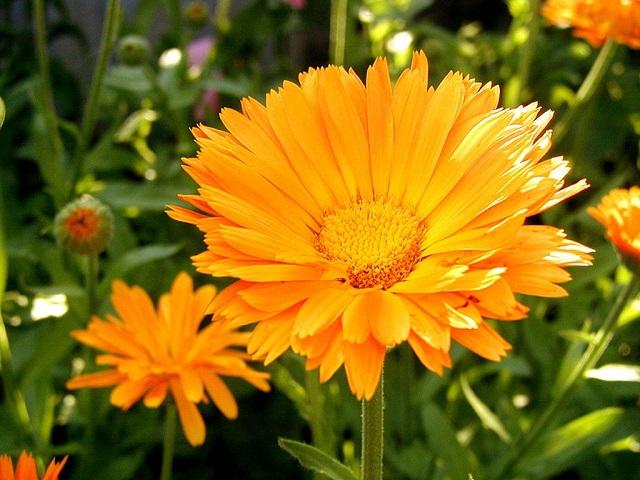

The exact dates when the calendula blooms cannot be named, since this depends on the method of disembarkation (sowing seeds in the ground or seedlings), growing conditions, temperature indicators. On average, flowering begins in late June and lasts until November - before the onset of cold weather.
The best varieties of decorative calendula include:
- Sonnenstein. The bush grows up to 50 cm tall, has strong ribbed shoots, painted in a light green color. The leaves are also quite large, oblong, of the same color. Baskets are bright yellow, up to 7.5 cm in diameter.
- Juwel. The bush grows spherical, the shoots are light green, the leaves are large. Terry inflorescences, 5-8 cm in diameter. Reeds are flat salmon-orange.
- Radio. The bush grows up to 45 cm tall, the shoots are strong, ribbed. Leaves are oblong with raised veins. The inflorescences are double and semi-double, 6-7 cm wide. The flowers are bright orange, rolled up to the middle into a tube.
- Sensation... It differs from the previous variety in reed flowers - they are large and shiny, located in the form of a tile.
- Meistershtyuk - the height reaches 45 cm, the leaves expand upward. Baskets have a diameter of 6-8 cm. Ligulate flowers are slightly concave, oar-shaped.


Soil preparation
It is possible to plan the cultivation of marigolds only for the next season.These are the features of soil preparation at the site of the planned planting. They begin to prepare the soil in the fall:
- The site is dug several times deep into the bayonet of a shovel, so that the earth becomes loose and pliable to mixing.
- For one square meter of the plot, phosphorus and potash fertilizers are mixed into the soil about one tablespoon and about four kilograms of compost.
- For clay soils, coarse sand is additionally added, approximately 7 liter bucket per square meter.
A simpler, rustic way is to replace fertilizer with furnace ash.
Content
- Description
- Growing calendula from seeds Sowing seeds in the ground
- Sowing seedlings
- Seedling care
- When to plant
- How to grow
- How and when to collect seeds
- Beneficial features
Combination with other plants
The flowering of calendula is a picture of amazing beauty. In the garden, it looks harmonious both in a single version and in a group planting. An excellent location option - in the center or along the edge as a frame for the heart of the garden. Low-growing varieties are great for decorating hedges and garden paths. Islets of lush blooming calendula will look spectacular in the middle of the lawn grass. The plant goes well with shrubs, including conifers. As for the color scheme, the calendula, whose flowers are painted in yellow-orange tones, looks great with burgundy, blue and purple flowers. In addition to its aesthetic value, calendula has the ability to scare off parasites with an unpleasant odor for them, which has a beneficial effect on the condition of neighboring plants, including asters (prevents the development of a black leg), gladioli, as well as berries (for example, strawberries) and vegetables.


In particular, the presence of calendula protects against such pests, as:
- nematodes;
- bear;
- ticks;
- aphid (the plant takes on the attack of the parasite);
- Colorado beetle;
- hawk moth caterpillars.
Thus, calendula can be used not only for decorative purposes, but also for practical purposes.
Positive impact on the vegetable garden
Surprisingly, but the plant helps not only the human body, but also helps to protect the crops grown in the beds. The secret lies in the fact that marigolds secrete phytoncides, which at least scare off pests, and on some they are destructive.
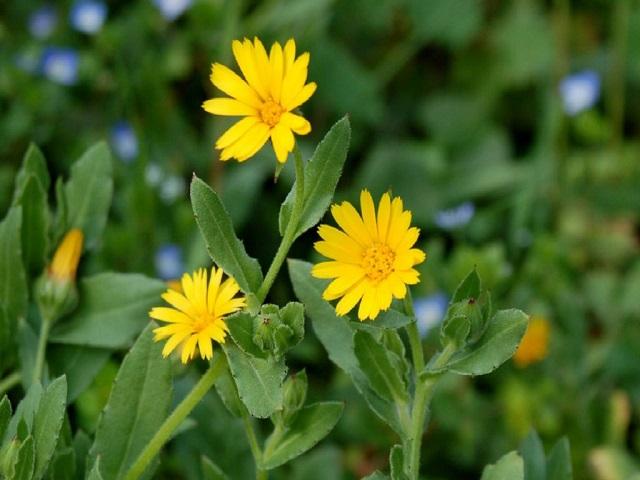

Planting calendula will keep strawberries from attack by nematodes. In addition, the plant will help get rid of the bear, asparagus fly, hawk moth caterpillar.
The green part of the flower is used as a green manure. The procedure removes the soil from nightshade phytophthora and nematodes. If the calendula is grown from seed, then for green manure, the optimal period will be the beginning of spring and August.


